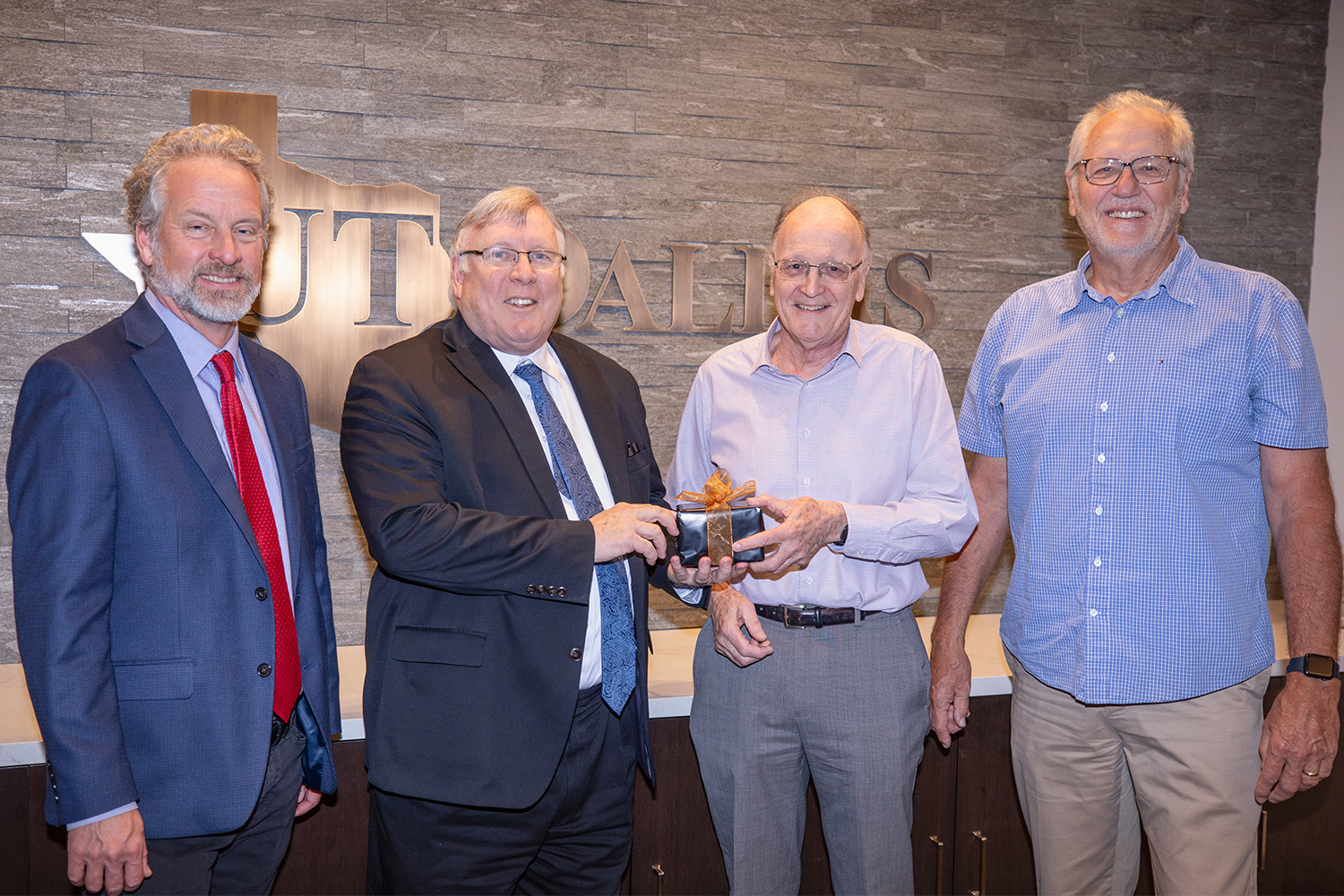50 Years and Counting: Space Scientist Recognized for Distinguished Career
 Dr. Roderick Heelis (second from right), former director of the William B. Hanson Center for Space Sciences, receives his 50-year service award from UT Dallas President Richard C. Benson in January. Joining the ceremony were Dr. David Hyndman (left), dean of the School of Natural Sciences and Mathematics, and Phillip Anderson MS’85, PhD’90, current director of the center.
Dr. Roderick Heelis (second from right), former director of the William B. Hanson Center for Space Sciences, receives his 50-year service award from UT Dallas President Richard C. Benson in January. Joining the ceremony were Dr. David Hyndman (left), dean of the School of Natural Sciences and Mathematics, and Phillip Anderson MS’85, PhD’90, current director of the center.
01.30.2024
When Dr. Roderick Heelis moved from Sheffield, England, to take a research scientist position at The University of Texas at Dallas in 1973, the 4-year-old campus was little more than a building in the middle of a cotton field.
Even so, the research program in atmospheric and space sciences, led by Dr. William B. Hanson, who recruited Heelis, was robust and well-funded through grants from NASA and other agencies. The program in the School of Natural Sciences and Mathematics is a carryover from UT Dallas’ precursor institution – the Southwest Center for Advanced Studies – which attracted top-caliber faculty in physics and astrophysics, as well as experts who designed space-based instruments to study the Earth’s upper atmosphere, the moon and other planets.
For 50 years, Heelis has conducted research on the ionosphere, a region of the upper atmosphere where disturbances can disrupt navigation systems and GPS signals to and from satellites. In January he received his 50-year service award – a watch bearing the UT Dallas seal – from University President Richard C. Benson, who is the Eugene McDermott Distinguished University Chair of Leadership.
“Over the years we have been fortunate to be at the forefront of science investigations that have a substantial impact on space-based communications and navigation,” Heelis said. “That, combined with our development of unique instrumentation for sensing charged particles in the atmosphere, has kept UTD in a great place for continued success.”
Heelis became director of the William B. Hanson Center for Space Sciences in 1994, succeeding Hanson.
“In the early days of UTD, parking lots C and D used to be well-mown fields, where Bill Hanson and I would hit golf balls after work,” Heelis recalled. “Those times led to some pretty good ideas for new science and new instruments, and a drive down what is now Bryce Jordan Drive still brings a smile to my face.”
Heelis was a Distinguished Chair in Natural Sciences and Mathematics when he stepped down as the Center for Space Sciences director in 2022. Phillip Anderson MS’85, PhD’90, a professor of physics who succeeded Heelis as center director, said he considers himself fortunate to have had Heelis as a mentor, colleague and friend for nearly 40 years. Heelis was part of his PhD committee.
“Rod is one of the giants in our field. His contributions are tremendous and include well over 200 publications with over 7,000 citations,” Anderson said. “He has been responsible for the production and deployment of numerous spacecraft and rocket instruments and several scientific advancements in space science research. He is also an excellent teacher, one of the very best at UTD.”
Heelis carries on his work as a research professor as he splits his time between UT Dallas and Logan, Utah, where he said he hopes to retire – someday.
“As the University has grown, so, too has the Center for Space Sciences,” Heelis said. “I am particularly proud to have assembled such a talented group of scientists and engineers who have remained in the center and nurtured its growth alongside me. Such a well-functioning group allows everyone to operate at their best.”
–Amanda Siegfried
Tags: Dr. Rod Heelis, NSM, Space Sciences